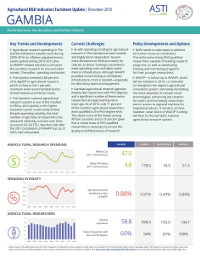Authors:
GAMBIA Nienke Beintema, Demba Jallow, and Kathleen Flaherty
Year:
2018
Publisher
International Food Policy Research Institute and National Agricultural Research Institute.
Back to:
Key trends and developments
- Agricultural research spending in The Gambia followed a volatile trend during 2000–2016 (in inflation adjusted terms). Levels spiked during 2010–2012 due to WAAPP-related activities to enhance the country’s research on rice and other cereals. Thereafter, spending contracted.
- The Gambia invested 0.88 percent of its AgGDP in agricultural research, which is close to the 1 percent minimum level recommended by the United Nations and African Union.
- The Gambia’s national agricultural research system is one of the smallest in Africa, and capacity in the higher education sector is extremely limited. Despite spending volatility, the total number of agricultural researchers has remained relatively constant over time, at around 45–60 FTEs. Numbers fell after the 2012 completion of WAAPP but, as of 2016, had rebounded.
Current challenges
- As with spending, funding for agricultural research in The Gambia has been volatile and highly donor-dependent. Govern- ment allocations to NARI are mainly for salaries, so donor funding is essential to meet operating costs and allow invest- ment in infrastructure. Although WAAPP provided some funding to rehabilitate infrastructure, more is needed—especially for laboratory space and equipment.
- Gambian agricultural research agencies employ few researchers with PhD degrees, and a significant number of these senior researchers are approaching retire- ment age. As of 2016, only 11 percent of the country’s agricultural researchers were qualified to the PhD-degree level. This share is one of the lowest among African countries and is of concern given that a critical mass of PhD-qualified researchers is necessary to ensure the quality and effectiveness of research.
Policy developments and options
- NARI needs to take steps to address its human resource constraints. This will involve hiring PhD-qualified researchers capable of leading research programs, as well as developing training and mentoring programs for their younger researchers.
- WAATP—a follow-up to WAAPP, which will be initiated in 2019—is intended to strengthen the region’s agricultural innovation system, ultimately facilitating the mass adoption of climate-smart technologies, enhancing job creation for youth, and increasing value chain actors’ access to regional markets for targeted products. It remains unclear, however, what share of WAATP funding will flow to The Gambia’s national agricultural research system.

